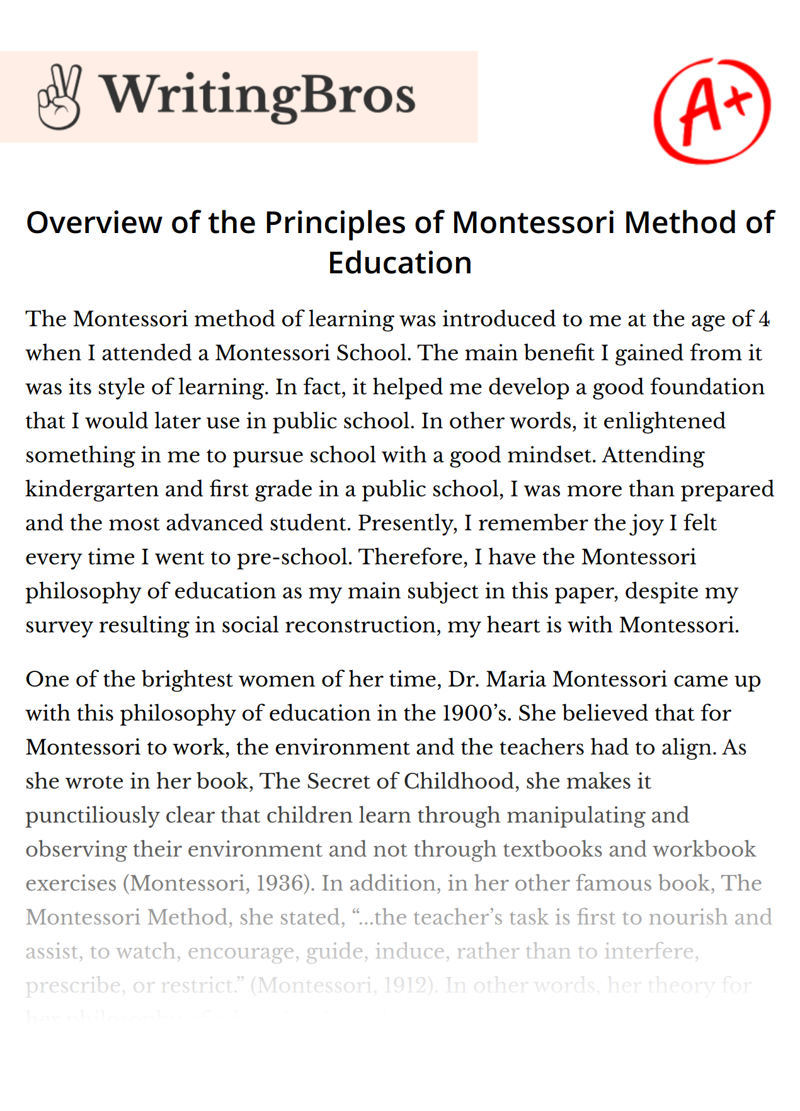Overview of the Principles of Montessori Method of Education
 Read Review
Read Review
 Read Review
Read Review

The Montessori method of learning was introduced to me at the age of 4 when I attended a Montessori School. The main benefit I gained from it was its style of learning. In fact, it helped me develop a good foundation that I would later use in public school. In other words, it enlightened something in me to pursue school with a good mindset. Attending kindergarten and first grade in a public school, I was more than prepared and the most advanced student. Presently, I remember the joy I felt every time I went to pre-school. Therefore, I have the Montessori philosophy of education as my main subject in this paper, despite my survey resulting in social reconstruction, my heart is with Montessori.
One of the brightest women of her time, Dr. Maria Montessori came up with this philosophy of education in the 1900’s. She believed that for Montessori to work, the environment and the teachers had to align. As she wrote in her book, The Secret of Childhood, she makes it punctiliously clear that children learn through manipulating and observing their environment and not through textbooks and workbook exercises (Montessori, 1936). In addition, in her other famous book, The Montessori Method, she stated, “...the teacher’s task is first to nourish and assist, to watch, encourage, guide, induce, rather than to interfere, prescribe, or restrict.” (Montessori, 1912). In other words, her theory for her philosophy of education is student-centered to help students become model citizens.
Another child development theorist is Angeline Lillard, whose conclusion is that schools should be designed for the optimal learning experience for the child. In simplistic terms, the educational system should be designed to suit the way that children naturally learn and develop. In her book, Montessori: The science behind the genius, she dives down into the extensive compilation of educational research that backs up her theories (Lillard, 2017). She does this through laying out the eight principles of Montessori education, revealing that scientists are now confirming its effectiveness, following scientific analysis and experimentation, how it connects and how it supports modern psychology. In general, her book follows the science behind Montessori.
Lastly, Shannon Helfrich, Montessori teacher from the last 50 years and author of Montessori Learning in the 21st Century: A Guide for Parents and Teachers, makes a strong case that even though Montessori was established a long time ago, it still correlates to the present. Her data in neurological/psychological studies supports her theory that the Montessori method should be used more in schools. Using diagrams and photographs throughout her book, she explains how the brain develops and why interconnections with the environment is requisite at specific points in a child’s development. (Helfrich, 2011). Helfrich also includes many reminiscences from classroom experiences with children that support these findings. In addition to this, she shared her experience as a teacher’s trainer to help parents and Montessori teachers perceive circumstances that impact the learning development for children in their early years.
In my ideal Montessori classroom, the fundamental key is for the teacher to use their knowledge of child development to create an environment that nurtures independence, order, confidence, and concentration in their students. There is not any homework or comparison; the classroom is intentionally prepared for students to choose the activity they want to work on. This is supporting a students' desire to learn on their own terms, on their own interests. This environment has freedom within limits to help the students learn about respect for others, themselves, and the environment. This philosophy encourages independence, as its founder, Maria Montessori, once said that, “if a child can do something by themselves, don't ever do it for them.” Moreover, the classroom setting is beautiful, warm and welcoming for the students. It is a light-colored themed classroom where everything is well organized, orderly harmonious, bright with items such as plants, or potentially class pets that the kids can take care of. All in all, this helps them with their mental development.
Cite this Essay
To export a reference to this article please select a referencing style below




